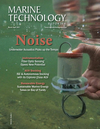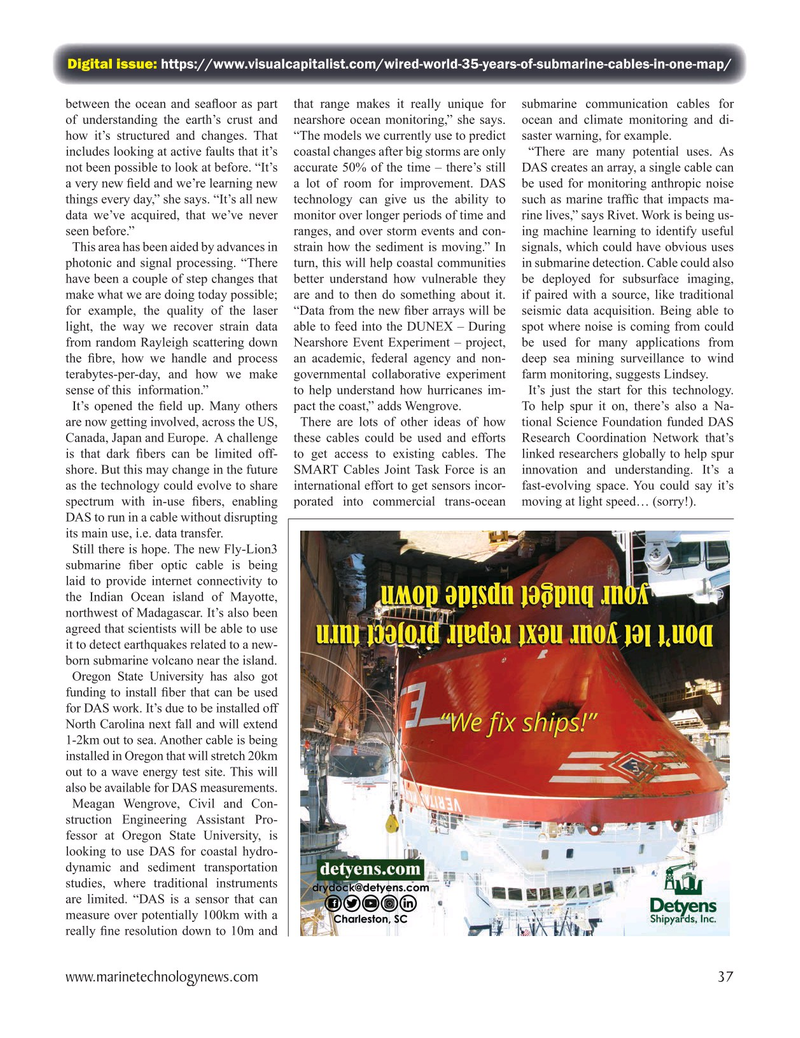
Page 37: of Marine Technology Magazine (March 2021)
Oceanographic Instrumentation & Sensors
Read this page in Pdf, Flash or Html5 edition of March 2021 Marine Technology Magazine
Digital issue: https://www.visualcapitalist.com/wired-world-35-years-of-submarine-cables-in-one-map/ between the ocean and sea? oor as part that range makes it really unique for submarine communication cables for of understanding the earth’s crust and nearshore ocean monitoring,” she says. ocean and climate monitoring and di- how it’s structured and changes. That “The models we currently use to predict saster warning, for example. includes looking at active faults that it’s coastal changes after big storms are only “There are many potential uses. As not been possible to look at before. “It’s accurate 50% of the time – there’s still DAS creates an array, a single cable can a very new ? eld and we’re learning new a lot of room for improvement. DAS be used for monitoring anthropic noise things every day,” she says. “It’s all new technology can give us the ability to such as marine traf? c that impacts ma- data we’ve acquired, that we’ve never monitor over longer periods of time and rine lives,” says Rivet. Work is being us- seen before.” ranges, and over storm events and con- ing machine learning to identify useful
This area has been aided by advances in strain how the sediment is moving.” In signals, which could have obvious uses photonic and signal processing. “There turn, this will help coastal communities in submarine detection. Cable could also have been a couple of step changes that better understand how vulnerable they be deployed for subsurface imaging, make what we are doing today possible; are and to then do something about it. if paired with a source, like traditional for example, the quality of the laser “Data from the new ? ber arrays will be seismic data acquisition. Being able to light, the way we recover strain data able to feed into the DUNEX – During spot where noise is coming from could from random Rayleigh scattering down Nearshore Event Experiment – project, be used for many applications from the ? bre, how we handle and process an academic, federal agency and non- deep sea mining surveillance to wind terabytes-per-day, and how we make governmental collaborative experiment farm monitoring, suggests Lindsey. sense of this information.” to help understand how hurricanes im- It’s just the start for this technology.
It’s opened the ? eld up. Many others pact the coast,” adds Wengrove. To help spur it on, there’s also a Na- are now getting involved, across the US, There are lots of other ideas of how tional Science Foundation funded DAS
Canada, Japan and Europe. A challenge these cables could be used and efforts Research Coordination Network that’s is that dark ? bers can be limited off- to get access to existing cables. The linked researchers globally to help spur shore. But this may change in the future SMART Cables Joint Task Force is an innovation and understanding. It’s a as the technology could evolve to share international effort to get sensors incor- fast-evolving space. You could say it’s spectrum with in-use ? bers, enabling porated into commercial trans-ocean moving at light speed… (sorry!).
DAS to run in a cable without disrupting its main use, i.e. data transfer.
Still there is hope. The new Fly-Lion3 submarine ? ber optic cable is being laid to provide internet connectivity to the Indian Ocean island of Mayotte, northwest of Madagascar. It’s also been agreed that scientists will be able to use it to detect earthquakes related to a new- born submarine volcano near the island.
Oregon State University has also got funding to install ? ber that can be used for DAS work. It’s due to be installed off
North Carolina next fall and will extend 1-2km out to sea. Another cable is being installed in Oregon that will stretch 20km out to a wave energy test site. This will also be available for DAS measurements.
Meagan Wengrove, Civil and Con- struction Engineering Assistant Pro- fessor at Oregon State University, is looking to use DAS for coastal hydro- dynamic and sediment transportation studies, where traditional instruments are limited. “DAS is a sensor that can measure over potentially 100km with a really ? ne resolution down to 10m and www.marinetechnologynews.com 37
MTR #3 (34-49).indd 37 3/22/2021 9:15:08 PM

 36
36

 38
38
